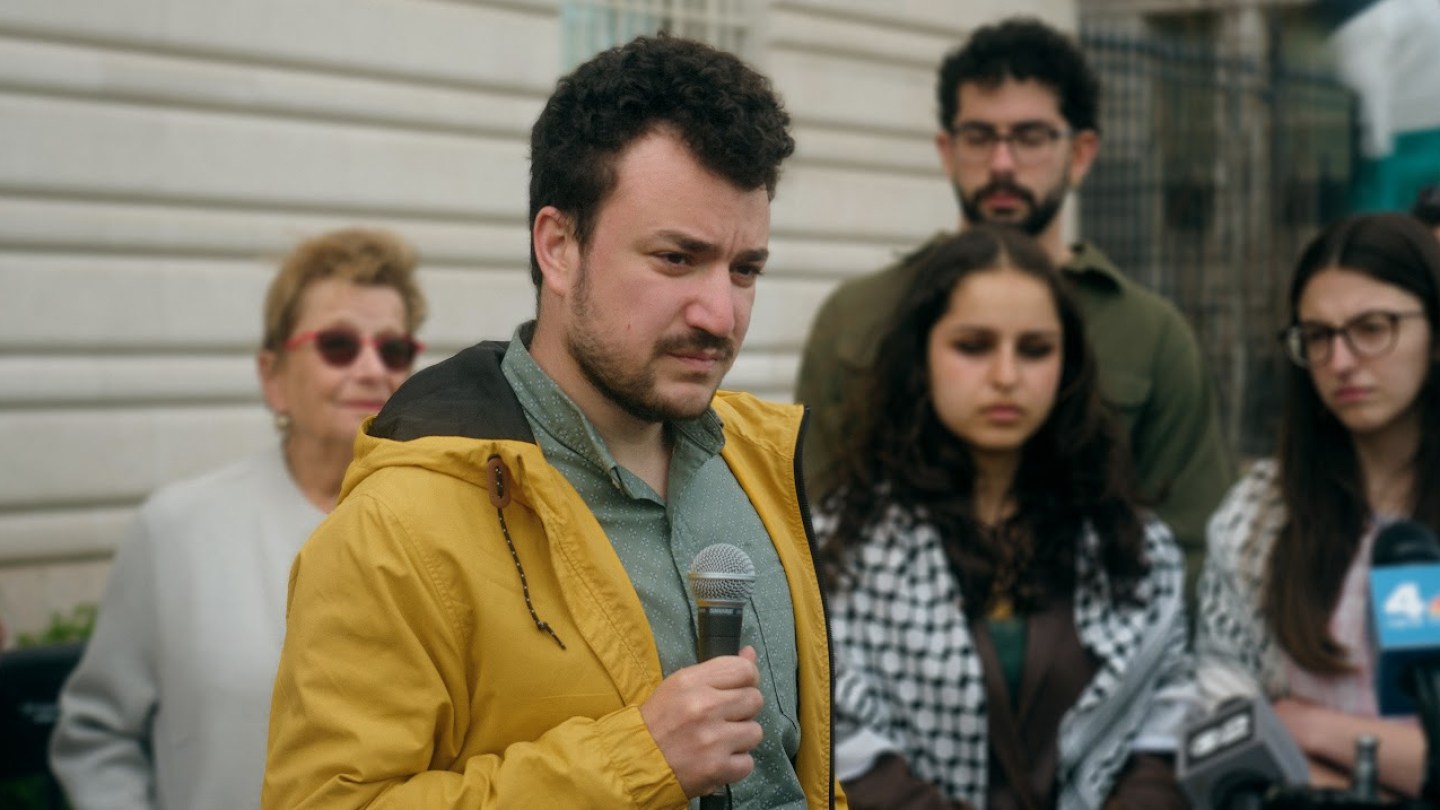
On April 17, 2024, under the darkness of early morning, a group of Columbia University students set up camp on Butler Lawn, a grassy area in the middle of campus. They pitched tents, gathered provisions and laid out homemade signs that declared the small patch a “liberated zone.” According to students interviewed in Kei Pritsker and Michael T. Workman’s propulsive new documentary The Encampments, campus organizers had been petitioning the administration to divest from Israel, but their requests were ignored and participation in peaceful protests criminalized. They needed to try something new, to make it harder for the university to dismiss their concerns.
Released by Watermelon Pictures and executive produced by Macklemore, The Encampments chronicles how students at Columbia ignited a far-reaching and influential solidarity movement last spring. Their encampment inspired peers on college campuses across the United States and around the world to stand with Palestinians in Gaza and urge administrations to divest from weapons manufacturers. The demonstration also instigated non-stop discussion by certain politicians and some members of the media, who spent weeks denigrating students, questioning their motives and accusing them of anti-semitism.
The Encampments
The Bottom Line
A compelling fly-on-the-wall document.
Release date: March 28
Directors: Kei Pritsker, Michael T. Workman
1 hour 21 minutes
Pritsker and Workman closely follow four crucial encampment participants in their brisk, fly-on-the-wall film: Mahmoud Khalil, a Palestinian student who was chosen to be the lead negotiator between encampment activists and university administrators; Sueda Polat, a first-year graduate student at the time who organized for Palestine on-campus before the encampments; Grant Miner, a Jewish graduate student and president of the Columbia student workers union; and Naye Idriss, a Columbia alum who still organizes for Palestine.
Their testimonies serve as a gripping oral history of the demonstrations and also offer informative context for the university’s years-long student-led divestment campaign. The doc also delves into the fascinating history of protest movements at Columbia, featuring conversation with alumni who participated in anti-Vietnam War protests in 1968, which also resulted in the occupation of several university buildings.
Watermelon Pictures, which distributed the Oscar shortlisted film From Ground Zero, rushed to release The Encampments in the U.S. following its world premiere at CPH:DOX after Khalil was arrested by ICE agents on March 8 and Miner was expelled by Columbia on March 13. Although the State Department tried to revoke his student visa, Khalil is a lawful permanent resident and is being held without any criminal charges. A judge recently ruled that Khalil could be deported, but his case is still ongoing and has attracted significant criticism because it so clearly violates the First Amendment. Miner was one of nearly two dozen students sanctioned by Columbia for their involvement in last spring’s demonstrations.
These recent events have made The Encampments, already important for documenting an impactful protest movement, even timelier. It’s part of a cadre of recent films that are conveying the stakes of this defining conflict. Whereas No Other Land and From Ground Zero capture the real-time impact of Israel’s unchecked encroachment on the West Bank and violence in Gaza, The Encampments reveals how the issue is playing out stateside. The doc observes students shaping and driving courageous forms of conversation among themselves and with their institutions.
Pritsker and Workman open The Encampments with a compilation of news anchors criticizing the encampments and footage from Gaza before introducing the four principal participants of the doc. Polat, Khalil and Miner introduce themselves, talk about their respective histories of organizing for Palestine on campus and reflect on the various ways the university ignored calls for divestment from the student body. While Polat offers a brief overview of Columbia’s endowment and board of trustees, and cites examples of the administration choosing to divest from specific countries in the past (like South Africa), this thread could realistically be the subject of its own documentary.
Polat’s explanation gives just enough context to help viewers understand the stakes of the student-led divestment campaign. When campus organizers decided to occupy Butler Lawn, they felt it was the only way to really get the administration’s attention. Part of what’s fascinating about The Encampments is how Pritsker and Workman place current activists within Columbia’s history of student movements. They interview Jamal Joseph, an alum who helped organize the occupation of Hamilton Hall in 1968 to protest the Vietnam War, and include archival footage of that demonstration. These are similar, if not the same, images as were included in parts of Paul Cronin’s epic documentary A Time to Stir, which chronicled Columbia students’ anti-war actions.
Like the 1968 demonstrators, the encampment students also occupied a building. Days into their action, some organizers snuck into Hamilton Hall and renamed it Hind’s Hall after Hind Rajab, a six-year-old Palestinian girl who was killed by the Israeli military in Gaza. In audio recordings of her and emergency call operators, some of which are played in The Encampments, Rajab can be heard pleading for someone to come save her.
To show the influence of Columbia’s protests, Pritsker and Workman smartly widen the scope of the doc to include footage from other university encampments. Interviews with Maya Abdallah, a Palestinian student at UCLA, give another perspective on how demonstrations were received elsewhere in the country.
The Encampments takes a harrowing turn once the filmmakers observe university responses to the student occupations spreading across campuses. Scenes of Jewish students at Columbia wearing kippahs adorned with watermelons (symbolizing solidarity with Palestine), leading fellow demonstrators in prayer or song, and Palestinian organizers offering skill-sharing workshops give way to New York City police officers clad in military-grade gear, rolling onto campus with their tanks and heavy artillery. They destroy the camp and arrest the students. At UCLA, the police throw smoke bombs into crowds and pelt protesters with rubber bullets.
These moments echo Columbia’s 1968 protests, in which the university also responded with violence. That the use of a militarized police force on protesters has become so commonplace in the last decade should concern all Americans, especially as the Trump administration continues to act in ways that violate protected rights. The Encampments is not just critical in capturing the real-time makings of a movement, but in laying bare the consequences of this response.
#Doc #Gaza #Protests #Columbia






